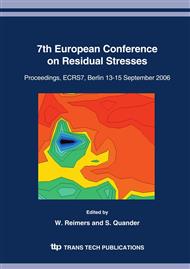[1]
D.V. Nelson, in: Residual Stress Effects in Fatigue, ASTM STP 776 (1982) 172-187.
Google Scholar
[2]
V.M. Leitao, M.H. Aliabadi, D.P. Rooke and R. Cook, J Mat. Eng. & Perf., Vol. 7 (1998) 352360.
Google Scholar
[3]
H. F Bueckner, Zeit. für Angewandte Math. und Mech., Vol 50, (1970)529-546.
Google Scholar
[4]
J.R. Rice, Int. J. Solids Struct., Vol. 8 (1972) 751-758.
Google Scholar
[5]
A.P. Parker, in: Residual Stress Effects in Fatigue, ASTM STP 776 (1982) 13-31.
Google Scholar
[6]
G. Glinka in: Fracture Mechanics ASTM STP 677 (1979) 198-214.
Google Scholar
[7]
K. Masubuchi and D.C. Martin, Weld. J. Vol. 40 (1961) 553-563.
Google Scholar
[8]
J. M-L. Tan, M. E Fitzpatrick and L. Edwards, submitted to Eng Fract Mech.
Google Scholar
[9]
J. M-L. Tan, M. E Fitzpatrick and L. Edwards, in: Proc. ICAF 2005 EMAS, Cradley Heath, UK.
Google Scholar
[10]
M. E. Fitzpatrick and L. Edwards, J. Mat. Eng. & Perf., Vol. 9 (1978) 190-198.
Google Scholar
[11]
A.T. Ozdemir, R. Cook, R., and L. Edwards, in Durability and Structural Integrity of Airframes, Proc. ICAF 1993, EMAS, UK, Vol. 1, (1993) 207-237.
Google Scholar
[12]
D. Stefanescu, A. Steuwer, R. A. Owen, B., Nadri, L, Edwards, M.E., Fitzpatrick and P J Withers, J. Strain Anal. Eng. Des., Vol 39, (2004) 459-469.
DOI: 10.1243/0309324041896470
Google Scholar
[13]
D. Stefanescu, L. Edwards, and M.E. Fitzpatrick, Int. J. Fatigue, Vol. 25 (2003) 569-576.
Google Scholar
[14]
E.T. Eastbrook, B.D. Flinn, C. Meyer, and N. Juhlin, N. The StressWave Fatigue life Enhancement Process. in Proc. 2001 Aerospace Congress, SAE 2001-01-2578. (2001).
DOI: 10.4271/2001-01-2578
Google Scholar
[15]
A.F. Liu, AIAA J., Vol. 22 (1984) 1784-1785.
Google Scholar
[16]
A.F.J. Grandt, Int. J. Fracture, Vol. 11 (1975) 283-294.
Google Scholar
[17]
J.A. Harter, AFGROW Users Guide and Technical Manual. (2004)AFRL-VA-WP-TR-(2004).
Google Scholar
[18]
R.G. Forman, V. Shivakumar, S. Mettu, and J.C. Newman, (2000)NASGRO Version 3. 00 Reference Manual : Fatigue crack growth computer program, NASA Document JSC-22267B.
Google Scholar
[19]
Z. Wang and X. Zhang, Int. J. Fatigue, Vol. 25 (2003) 1285-1291.
Google Scholar
[20]
A. T Ozdemir and L. Edwards Fat & Fract Eng Mar Str, Vol. 3 (1998) 12-15.
Google Scholar
[21]
D. Stephanescu, Ph. D Thesis (2001) Dept of Materials Engineering, Open University, UK.
Google Scholar
[22]
B. Nadri, Ph. D Thesis (2004) Dept of Materials Engineering, Open University, UK.
Google Scholar
[23]
J. M-L. Tan, S. Pratihar, M. E Fitzpatrick and L. Edwards, Residual Stress Redistribution in Fatigue-aged StressWave Cold-Worked holes, in: Proc. MECA-SENS (2005).
Google Scholar
[24]
L. Edwards, M.E. Fitzpatrick, P.E. Irving, I. Sinclair, X. Zhang, and D. Yapp. D. (2006) J ASTM Int Vol. 3, (2006) paper JAI12547, doi: 10. 1520/JAI12547.
Google Scholar
[25]
X. Zhang and Y. Li, AIAA J., Vol. 43 (2005) 1613-1623.
Google Scholar
[26]
X. Zhang, P.E. Irving, L. Edwards, M.E. Fitzpatrick, I. Sinclair, J. Lin and D. Yapp. D. (2006) in Proc ICAF 2005 EMAS, Cradley Heath, UK.
Google Scholar
[27]
S. Pratihar, S. Ganguly, J.A. James, M.E. Fitzpatrick and L. Edwards, in: Proc MECA-SENS (2005).
Google Scholar
[28]
J. M-L. Tan Ph. D Thesis (2006) Dept of Materials Engineering, Open University UK.
Google Scholar


